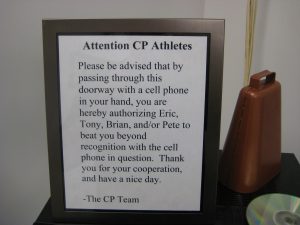Strength and Conditioning Programs: Eliminate Distractions to Gain Muscle, Lose Fat, Get Strong, and Take Over the World
As most of you are probably aware, Hurricane Irene worked its way up the East coast of the U.S. this past weekend and really threw people for a loop with flooding, power outages, fallen trees, and all sorts of damages. My wife and I got off pretty easily; we just had to go eight hours on Sunday without power – a far cry from what a lot of other folks encountered. And, our dog, Tank, was entertained all day as he played weatherdog and stared the window to watch the rain.
Oddly enough, those eight hours proved to be wildly productive for me. Thanks to a fully charged laptop battery, I was able to write a half dozen programs for clients, a blog, and the introduction of a new article for T-Nation. I read over 100 pages in a book, took a nap, and even went over to Cressey Performance to get a day ahead on my strength training program…in the dark and without music (for the record, this is one more reason free weights are better than machines: no electricity needed).
In short, it was an extremely productive day for me in comparison to typical Sundays in spite of the fact that the weather outside was miserable and it would have been very easy to get antsy from “cabin fever.” What made this day so much more productive than many others for me?
There were zero distractions.
No Facebook and no twitter. No emails or text messages. No television or phone calls. No absurdly painful “I feel like I’m shopping at Old Navy” techno playing on Tony’s iPod. It was absolute bliss.
Now, don’t get me wrong; human interaction is a huge part of my daily life as a coach, writer, consultant, and barrel-chested freedom fighter. I don’t just sit inside and think of ways to avoid human interaction so that I can be more productive. However, some peace and quiet sure is nice – and that’s why, in fact, that this blog is being written at 6:40AM. It’s an empty house with complete silence. In a few minutes, I’ll head over to the facility – an empty facility with complete silence. A good hour or so in there before anyone else arrives gives me the leg-up on the day that I need to be productive.
It’s taken me 360 words to get to my point, but the take home message is very simple:
If you want to be successful in your
strength and conditioning programs,
get rid of the distractions around you.
I talk to athletes about how everything they do takes them one step closer to their goals – or one step further away. Each decision they make should be a calculated choice that weighs pros and cons in the context of their goal.
For instance, a training partner can be a great addition to a strength and conditioning program – but it can be an unbelievable failure if that individual is always late for training, gets too chatty between sets, or is an inattentive spotter. That’s a distraction that you have complete control over keeping or removing from your life. A bad one can destroy you – but a great one can be a huge advantage.
However, most distractions aren’t so easy to eliminate. Family life, work, injuries, car troubles, inclement weather, busy gyms, and a host of other factors can all create stressful distractions that interfere with progress. The most successful clients I’ve encountered are the ones who understand how to balance all these competing demands and keep distraction out of the task at hand – whether it’s lifting or working on a big project.
Here are my top five suggestions on how to get rid of or manage some of the most common distractions and inconveniences that can sabotage your strength training program.
1. Leave your cell phone in the car – I can say without wavering that this is the single-biggest distraction I see nowadays, as mine rings off the hook on most days. However, back in March, I went nine days without mine while I was in Costa Rica and the world didn’t end. I’m happy to report that shutting yours off for 90 minutes won’t lead to any catastrophes – and you’ll get strong in the process. This sign over the gym entrance at CP says it all.
2. Always have a plan B – If you train in a busy commercial gym at peak hours, you know it can be pretty tough to get access to the exact equipment you need. Rather than stand around and wait 15-20 minutes for it, your best bet is to go into the session knowing what would be a suitable replacement for each strength exercise. The chest-supported row is taken? No worries; here’s a blog with a few good substitutes: No Chest-Supported Row? No Problem.
Here are a few other posts along these lines that might interest you:
High Performance Training without the Equipment – Part 1 (No Access to Dumbbells)
High Performance Training without the Equipment – Part 2 (External Rotations without Cables)
High Performance Training without the Equipment – Part 3 (Pushup Variations)
High Performance Training without the Equipment – Part 4 (More Pushup Variations)
The point is that no matter how busy your gym gets, there is always a plan B. In fact, post a comment with the most common “shortcoming” you have in terms of equipment access, and I’ll devote a future blog to the topic, outlining several potential substitutes for you. I like a good challenge.
3. When injured, there is always something you can do to get better – To be blunt, there is nothing that bothers me more in this world than people who constantly piss and moan about their circumstances. I’ve read that Walt Disney was once so broke that he ate dog food. Years back, Donald Trump went billions of dollars into combined business and personal debt – and he’s certainly turned out okay. Thomas Edison was yanked out of school at a young age because his teachers thought he was stupid – and he went on to teenage years in the workforce that consisted of being fired multiple times. Tiger Woods missed a big chunk of time – and an absurd amount of money – when he had his ACL reconstruction.
You, on the other hand, are going to turn into Johnny Raincloud because you have tennis elbow and can’t do your curls for a week? Cry me a river…somewhere else, please.
Put on a happy face and magical things happen. Figure out what you can do – and then do it.
Quit your complaining; whining is just your way of distracting yourself.
For more on this topic, check out Strength Training Programs: When Did “Just Rest” Become a Viable Option?
4. Have home training options – There are going to be times when life simply gets in the way of what you had planned. Maybe it’s a sick kid at home or inclement weather that prevents you from getting to the gym. At these times, it’s incredibly advantageous to have some equipment (or body weight training templates in mind) that you can use to ensure that your strength and conditioning program doesn’t miss a beat. Some kettlebells can be great, and I’m a big fan of the TRX. In fact, I liked it so much that I brought mine to Costa Rica, and when combined with sprinting on the beach, we had great training sessions all week.
5. Communicate with those around you – I think that one of the reason that some folks have issues with distractions with respect to exercise is that they don’t clearly relate to those around them that it’s important to them. Most people find time for training instead of making time for it. If it’s important to you, block it off in your schedule and let those around you know that this is the case; they’ll be more respectful of your “important time” and let you do your thing unless an emergency comes up.
These five tips are, of course, just a few of the many ways that you can eliminate distractions from your strength and conditioning programs. What strategies have you found to be useful when it comes to keeping your focus?
Related Posts
Workout Routines: Exercising on Vacation – Part 1
Workout Routines: Exercising on Vacation – Part 2






